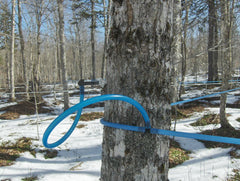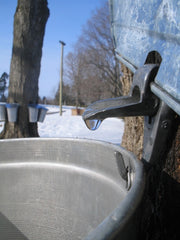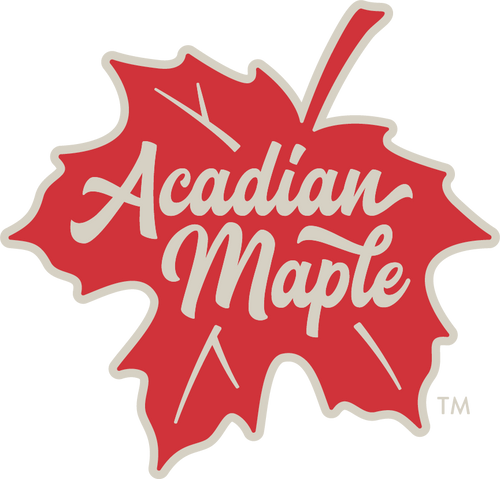Making maple syrup is easy and fun. How to make maple syrup from a tree is one of the most common questions we get asked. Let's read on and find out how.
Making Maple Syrup Step 1
First, you drill a small hole in a maple tree then you insert a spout and collect the sap that drips out of the tree. This sap is mildly sweet and is mostly made up of water with a small amount of sugar.
Making Maple Syrup Step 2
Once the sap is collected you need to remove some of the water. So you simply boil the sap in a pot on a stove. As the sap boils, the water is removed and the amount of sugar in the liquid is concentrated.
Making Maple Syrup Step 3
Once you have removed enough water and cooked the sap to a concentration of 66-68% sugar you have pure maple syrup. Yes, it’s that easy and it’s fun for the whole family!
What you Need to Make Maple Syrup
- Live in an area where maple syrup can be harvested. This area is the North Eastern part of North America.
- Have maple trees on your property or willing neighbours that will let you use their trees!
- A drill, some spouts and buckets.
- A pan or pot and a stove or propane burner.
Where can I Make Maple Syrup?
Maple syrup can only be made in North Eastern North America. This includes as far south as Pennsylvania and as far west as Ontario. The top North East section of North America is known as the maple belt and it’s where all of the world’s maple syrup is produced.
Luckily here in Nova Scotia, we are in this maple belt. If you don’t live in this area, you probably still have maple trees but not the type that can be tapped. Unfortunately, you’ll have to buy your maple syrup at a store.
Your reading this you probably know many but just in case there are some great ways to use maple syrup.
How to Make Maple Syrup From a Tree
So you live in the maple belt. The next step is to determine if you have any maple trees in your yard. There are a lot of different kinds of maple trees in the world but the two primary kinds from which you can produce maple syrup are the sugar maple and the red maple.
Sugar maples usually grow at higher elevations and red maples at lower elevations. Both are easily identified in the summer while they have leafs but in the winter you need to use the bark to identify your maple trees.
One thing you can do is identify your maple trees in the summer and then tie a string around them or use some marking tape in order to easily identify them in the winter once the leafs are gone.
Identify a Sugar Maple Tree
The sugar maple is the preferred tree to produce maple syrup. The primary  reason is that the sugar maple has a higher percentage of sugar in its sap (2-3%) so you don’t need as much to make syrup. How to identify a maple tree: Look for a hardwood tree with smooth grey bark. As the sugar maple grows older the bark can become very rough and fissured and also turn a darker grey.
reason is that the sugar maple has a higher percentage of sugar in its sap (2-3%) so you don’t need as much to make syrup. How to identify a maple tree: Look for a hardwood tree with smooth grey bark. As the sugar maple grows older the bark can become very rough and fissured and also turn a darker grey.
Identify a Red Maple Tree
Some people will say that maple syrup made from the red maple is not as good as the sugar maple but don’t listen to them! In Nova Scotia, the red maple tree is more predominant. The sugar content of a red maple tree will be 1-2% so you will need more maple sap, but unless you have a massive commercial operation you don’t need to worry about it.
How to identify: Look for a hardwood tree with smooth grey bark (but darker than the sugar maple). As the tree ages, the bark can start to peel up and look like sheets about to fall off the tree.

How to Tap a Maple Tree to Make Maple Syrup
Once you have identified your maple trees you can start to tap them. When do you tap the trees? Maple season in Nova Scotia lasts anywhere from mid-February to mid-April. That’s it.
All of the maple syrup is made in this short season. When to tap maple trees is a very hard question to answer and is dependent on many things. The best thing to do is pay close attention to the weather.
In order for the maple tree to give us maple sap, the temperature has to go below freezing at night and above freezing during the day. This temperature difference causes a pressure difference in the tree which makes the sap run.
Watch the long-term weather forecast and when it looks like there is going to be a period of this freeze/thaw cycle coming up it is time to tap.
Tapping a Maple Tree
Grab your drill, sharp drill bit, bucket, hammer and spouts and head out into the yard. Look for a healthy maple tree and size it up. Never tap a tree that is less than 8 inches in diameter. These trees are too young.
Never put more than 1 tap in a single tree. Over-tapping a tree can really damage it. Look for good healthy wood. Do not tap damaged wood or rotten wood.

With your two feet on the ground and your two hands on the drill, make a hole in the tree 2 inches deep. DO NOT drill deeper than that. An easy way to do this is to measure your drill bit and mark 2 inches on the bit with a marker.
Once the hole is drilled remove the drill bit from the hole. If you keep the bit spinning when you pull it out it will pull all the sawdust and wood shaving out of the hole for you.
It's important to never blow in the hole to remove sawdust as it can introduce bacteria from your breath into the hole.
Grab one of your spouts and set it in the hole. With your hammer, lightly hammer the spout into the tree. Don’t hammer too hard, it just has to be in the hole firmly enough to be able to hold a bucket.
Try your very best not to crack or damage the bark around the tap hole.
Now, hang your bucket from the spout and attach the cover (if you have one). Now you’re ready to move on to your next tree. Repeat this process until all your trees are tapped.

How to Collect Maple Sap
Check on your trees and taps once a day (or more if you like) to see if the sap is running. Although it is referred to as "running" the sap actually just drips out of the tree.
Sometimes it’s a slow drip and sometimes it's a fast drip. It all depends on the weather and the season. Once you get some maple sap in your buckets it's time to collect it and make your very own maple syrup.
Maple sap is very perishable. If the weather is warm you'll want to collect your sap at least once a day and boil it. It's this precious maple sap that contains all the nutritional and health benefits that maple syrup contains over other sugars.
The longer your sap sits around out of the tree before it’s processed, the greater the chance you have of making off-flavoured or very dark maple syrup.
Use a nice clean bucket to collect your sap. Go from tree to tree removing the buckets and dumping the maple sap into your collecting bucket. Once the collecting bucket is full take it back home and pour the maple sap into a large pot on your stove or on a propane burner outside.

How to Process maple Sap into Maple Syrup
The sap now has to be concentrated into maple syrup. This is done through the process of boiling it. You simply boil the sap until enough water is removed and you are left with pure maple syrup.
This process generates a lot of steam so it may be worth doing it outside if you can because your kitchen can quickly fill with steam.
Light your stove or turn it on and let your sap boil away. Keep a close eye on it as you do not want your pot or pan to boil dry.
If the sap continues to run you can keep adding sap to the pot. If you run out of sap you will need to be very careful and remove it from the heat before it boils dry.
After enough sap has been added it will start to darken and turn the golden colour of maple syrup. So how do you know when it is done?

How to Tell When your Maple Syrup is Done
When you are boiling your sap and making maple syrup you know it’s done when it reaches 66% sugar (the measure of sugar is known as brix).
If the syrup is just for your own use we suggest using a thermometer. Put a candy thermometer in the boiling syrup and when the temperature reaches 7 degrees above the boiling point of water (219 F) it is generally finished.
Be careful though as the boiling point of water changes with barometric pressure and altitude.
It is a good idea to boil a pot of water on the stove and place your thermometer in the water to see what temperature the water is boiling at. Do this once a day and you should be good to go.
Don’t be too worried about burning it. Just be careful not to let your pot or pan go dry. Maple syrup that is under 66 brix (below 66% sugar) has too much water in it and can go mouldy.
Syrup over 68.5 brix (68.5% sugar) can start to form crystals. So watch your thermometer and go from there. You can also buy an inexpensive hydrometer specifically for maple syrup that will tell you when it’s done but the thermometer is the easiest method.
Another really easy way to tell when it’s done is to simply dip a spoon or long edged utensil in the boiling syrup. Lift it out and watch how it runs off the end. If the syrup "aprons" off the end you know it’s close to being done or is done.
Again, if maple syrup is not the correct sugar content it can start to ferment. So knowing your sugar content is crucial if you want to bottle and sell your maple syrup, but if it is just for your family and friends it is not as crucial.
How to Bottle Maple Syrup
Once your maple syrup is finished boiling it needs to be packaged. If you just made a little it is best to pour it into a pitcher of some sort and put it straight into the fridge. Keep it refrigerated and it should last for as long as you can keep from pouring it on your pancakes or use it to replace refined sugar in recipes.
If you made more than you can use or you want to give some away, your maple syrup can be poured into glass mason jars or other glass containers.
Always try to use new, clean glass containers. The maple syrup has to go into the container hot (at least 180F) and the cover needs to be put on immediately.
Once the cover is securely on, the container should be turned upside down so the hot maple syrup will sanitize the cap.
If you do package your maple syrup hot but you are not sure of the exact sugar content it is best to keep it refrigerated. Syrup below 66% sugar that is left unrefrigerated will start to go mouldy or ferment.
Maple Syrup Grades
Not all maple syrup is equal. Maple syrup comes in different grades. There are two grades, Grade A maple syrup and For Reprocessing maple syrup. Grade A, as you would guess is the high-quality stuff while off flavoured maple syrup or maple syrup that smells bad would not be considered Grade A maple syrup.
You can't just stick a grade on your maple syrup though. Here in Canada, you need to be registered with the Canadian Food Inspection Agency in order to apply a grade to your maple syrup.
Thanks for reading. We hope this guide helps you. Have some fun and make some delicious maple syrup!









